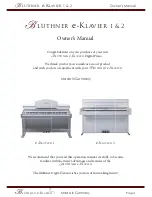
6
There are three major operating modes for the strobe:
Internal
,
External
Input,
and
Charging
(battery-powered model only). In the
Internal Mode
,
the knob adjusts the flash rate. In the
External Input Mode,
an external
signal is used to trigger the flash and the knob has no effect. The
Charging
Mode
(battery-powered model only) is when the strobe has the battery
recharger plugged into it. The strobe will continuously display the state of
the battery charge while being recharged.
4.1 Internal Mode - Standard Strobe Operation
In the
Internal Mode
, the stroboscope generates it’s own signals and
functions like a tunable stroboscope. The strobe is in the Internal Mode
when nothing is plugged into the input jack or when manually set using
the INPUT button.
To change the flash rate:
With the power on, turn the knob counter clockwise to increase the
flash rate and clockwise to decrease it. The knob is velocity sensitive.
Turn the knob slowly to have each “click” is equal to 0.01 FPM.
Turning the knob more quickly will adjust the FPM by larger steps.
When adjusting flash rate, quickly turn the knob (or use the
x2
or
÷2
buttons) to coarsely change the FPM. Then slowly turn the knob for
fine adjustments.
Note:
There are maximum and minimum values in each mode beyond
which you cannot adjust. If you are adjusting the rate and you reach a
value which on the next increment would exceed the maximum flash
rate, the display will not increment. The same is true if you try to adjust
the flash rate below the minimum flash rate.
To multiply or divide the current flash rate by 2:
In addition to the knob, there are two buttons on the display panel
marked
x2
and
÷2
. This enables the user to instantly double or halve
the reading on the display to the maximum or minimum values
allowed. This feature is useful for checking harmonics in the internal
flashing mode.











































